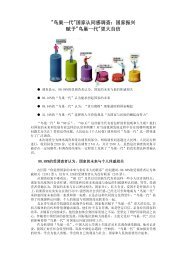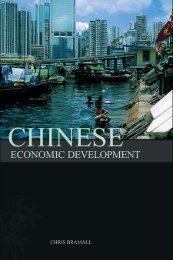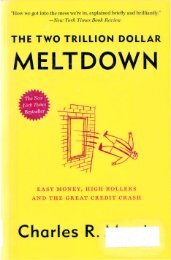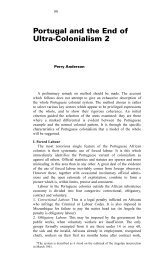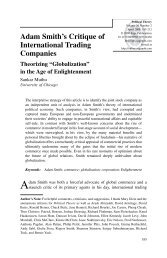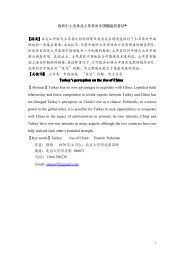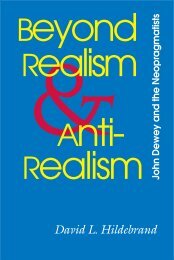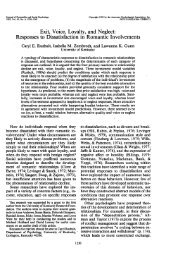Battle for China's Past : Mao and the Cultural Revolution
Battle for China's Past : Mao and the Cultural Revolution
Battle for China's Past : Mao and the Cultural Revolution
You also want an ePaper? Increase the reach of your titles
YUMPU automatically turns print PDFs into web optimized ePapers that Google loves.
argument that is widely circulated in <strong>the</strong> e-media is that <strong>the</strong>re is a difference<br />
between xi panzi (washing dishes) <strong>and</strong> jiao xuefei (paying tuition fees<br />
to study). The author of this argument starts with a well-known<br />
phenomenon that many PRC Chinese students, when in an affluent<br />
Western country, would ra<strong>the</strong>r wash dishes in a restaurant than study<br />
because <strong>the</strong> immediate cash income is too tempting, especially when<br />
compared with wages <strong>the</strong>y could earn in China. Those who wash dishes<br />
can earn <strong>and</strong> save enough money to buy a car (a luxury item in China)<br />
<strong>and</strong> even eventually a house. This is consumer culture. However <strong>the</strong><br />
o<strong>the</strong>r approach is to save <strong>and</strong> borrow to pay tuition fees to pursue a<br />
course of study. This would mean many years of hard work <strong>and</strong> of little<br />
consumption. The end result is totally different: those who study will<br />
eventually end up with a higher social status. This metaphorical comparison<br />
is used to argue that during <strong>the</strong> <strong>Mao</strong> era <strong>the</strong> Chinese had to work<br />
hard but to consume little (like someone paying tuition fees) so that<br />
eventually China could manage to build up an industrial <strong>and</strong> economic<br />
base to become <strong>the</strong> equal of <strong>the</strong> great global powers. The post-<strong>Mao</strong> strategy<br />
is like washing dishes to earn money to consume: China is now an<br />
assembly line of <strong>the</strong> world, or a gigantic low-technology migrant worker.<br />
The four modern inventions<br />
CHALLENGING THE HEGEMONY II<br />
Participants in <strong>the</strong> e-media debate constantly remind <strong>the</strong>ir readers that<br />
post-<strong>Mao</strong> China has hardly made any technological advance, <strong>and</strong> that all<br />
of China’s important industries that were built up during <strong>the</strong> <strong>Mao</strong> era<br />
have ei<strong>the</strong>r declined or been taken over by <strong>for</strong>eign companies (<strong>for</strong> more<br />
on this, see Chapter 9). Along <strong>the</strong>se lines, La (2007) presents a ‘four new<br />
inventions’ argument to show that <strong>the</strong> <strong>Mao</strong> era per<strong>for</strong>med better technologically.<br />
According to one poll survey of more than 50,000 respondents,<br />
<strong>the</strong> four winning entries of modern Chinese inventions, as opposed to<br />
<strong>the</strong> four old inventions of paper, compass, mobile printing <strong>and</strong> gun<br />
powder, are <strong>the</strong> hybrid rice crop (zajiao shuidao 杂交水稻), <strong>the</strong> laser typesetting<br />
<strong>and</strong> electronic publishing system of Chinese characters (hanzi<br />
jiguang zhaopai 汉字激光照排), artificial syn<strong>the</strong>tic crystalline insulin<br />
(rengong hecheng yidaosu 人工合成胰岛素) <strong>and</strong> <strong>the</strong> compound Arteme<strong>the</strong>r<br />
(fufang gaojiami 复方篙甲醚), <strong>the</strong> last being <strong>the</strong> malaria cure discovered at<br />
Mawangdui as discussed in Chapter 1. These technological inventions<br />
that have won <strong>the</strong> title of Modern China’s Four Most Important<br />
Inventions were all developed during <strong>the</strong> <strong>Mao</strong> era (Tian Fu 2007).<br />
In connection with this, <strong>the</strong> ab<strong>and</strong>onment of <strong>the</strong> Chinese development<br />
of civil aircraft Yun Shi (Transport 10) by <strong>the</strong> post-<strong>Mao</strong> authorities<br />
has been widely publicized in <strong>the</strong> e-media. One e-media participant<br />
even suggested that Shen Tu, <strong>the</strong> head of <strong>the</strong> Chinese Civil Aviation at<br />
<strong>the</strong> time, who later defected to <strong>the</strong> West, was ei<strong>the</strong>r a CIA spy or was<br />
[ 143 ]





